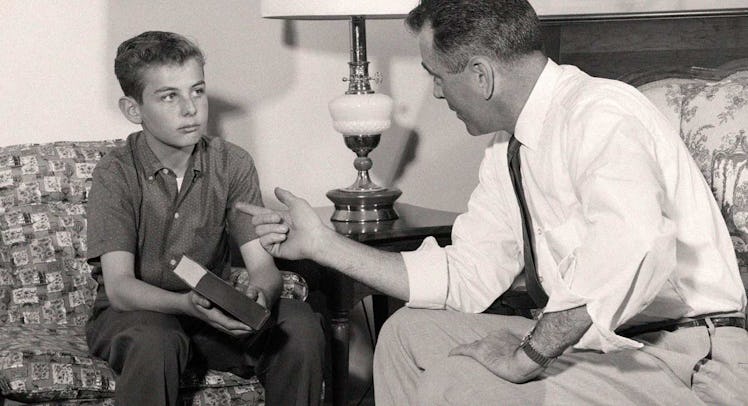How to Explain to a Child What is Bad and What is Worse
Kids need logic to understand the difference between bad choices and worse choices.

Moral leadership comes naturally, if not easily, to most parents. Teaching the difference between good and bad isn’t as easy as reading The Lorax, but it isn’t much more complicated than modeling behavior and implementing a time-out plan. That’s the good news. The bad news is that the world is not always good or bad and right and wrong. Sometimes it’s bad and worse or wronger and more wrongerer. A parent can either let their kid learn those lessons by allowing them to make painful mistakes, or by stepping beyond Seussian morality tales and providing their kids with a guided tour of the gray area.
It’s important to note there is a growing body of research that suggests children have a basic moral understanding by the time they turn one. This understanding can be demonstrated using a fairly standard experiment. Babies are asked to make a choice between a helper character or a hinderer character after watching both assist or impede the progress of someone trying to get up a hill. Overwhelmingly, babies choose the helper. They understand the idea of social good–at least in the context of slopes. As kids grow, parents augment this basic binary understanding and add more explicit categories into the good and bad. Good: saying thank you, sharing. Bad: lying, stealing. But what they often fail to teach explicitly is that sometimes a kid might have to choose to do something bad like not helping, in order to avoid something worse.
Michael Sabbeth, trial lawyer, ethicist, and author of The Good, The Bad and The Difference: How to Talk with Children About Values, spent years teaching children the gray areas that parents didn’t. “The concept that things are not always black and white is pretty banal,” Sabbeth says. “Kids understand that.” But he stresses that what they sometimes don’t understand is that morality can be situational and based on facts. “As the facts change, the morality changes.”
Because of this, the helpers in his scenarios are presented with harder options. In one example he discusses helping someone change a flat tire on the side of the road. The binary perspective is, yes, helping is good. But Sabbeth teaches kids that there needs to some analysis. “If you’re an 80-year-old man with an oxygen tank and you see 6 young men on the side of the road at night with no lighting, you might make a different choice.”
The idea is to help kids start thinking about options. Could the man stop at the next exit and tell someone at a gas station? Could he use a cellphone and call roadside assistance? Are there ways to help that do not present a possible danger? “The skill is to teach them how to think,” Sabbeth says.
And his suggestion is that kids can receive this education far earlier than parents might think. He began teaching ethics lessons as a visiting instructor to his son’s first grade class, when he was around 5-years-old. “You don’t go blasting them and giving them difficult questions right away,” says Sabbeth. “But they understand the basics with a great deal of clarity and confidence.”
The Four-Pronged Approach to Explaining Moral Gray Areas
- Ask children what they would do not just when no one is looking, but when everyone is looking.
- Teach ethical conundrums earlier than later. Even 4- or 5-year-olds can understand the concept that things are not always black and white.
- Pose questions that prompt analysis. Start with ethically straightforward examples and slowly add details that complicate the scenario.
- Measure answers by whether they strengthen character, competence, conscious, and clarity.
In his experience he learned never to underestimate the children he was working with regardless of their background or experience. In fact, he suggests, it’s better to teach ethical conundrums earlier than later. “I have no hesitation talking to 4-year-olds or 5-year-olds. You run into trouble when you get into college. Then it’s all on deaf ears.”
Sabbeth’s technique is what he calls his “attempt at the Socratic method.” In his classes he offered the children a mixture of historical, current and hypothetical scenarios (helping with a flat tire) where moral decisions had to be made and asked how they would approach the problem. But he did not ask them to make that decision without a way to measure their answer. The requirements for that answer? That it strengthen character, competence, conscious, clarity.
There will be some explanation regarding the vocabulary, but Sabbeth says that kids pick up on it pretty well. Importantly, there is one final note that helps kids understand the gray areas. “There’s a statement bandied about that character is tested by what you do when you’re alone,” says Sabbeth. “But I think character is measured also by what you do when the world is watching. Do you stand up for what is true and have the courage to do that?”
He explains one of the greatest “bads” a kid can face is losing a friend. They understand that concept. So talking out scenarios where the choice is between losing a friend or the kid or friend being harmed in some way are particularly helpful.
“You tell them this is the tough part, it’s a challenge. Are you going to be strong enough and do what’s right? Not just when no one is looking, but when everyone is looking?”
This article was originally published on